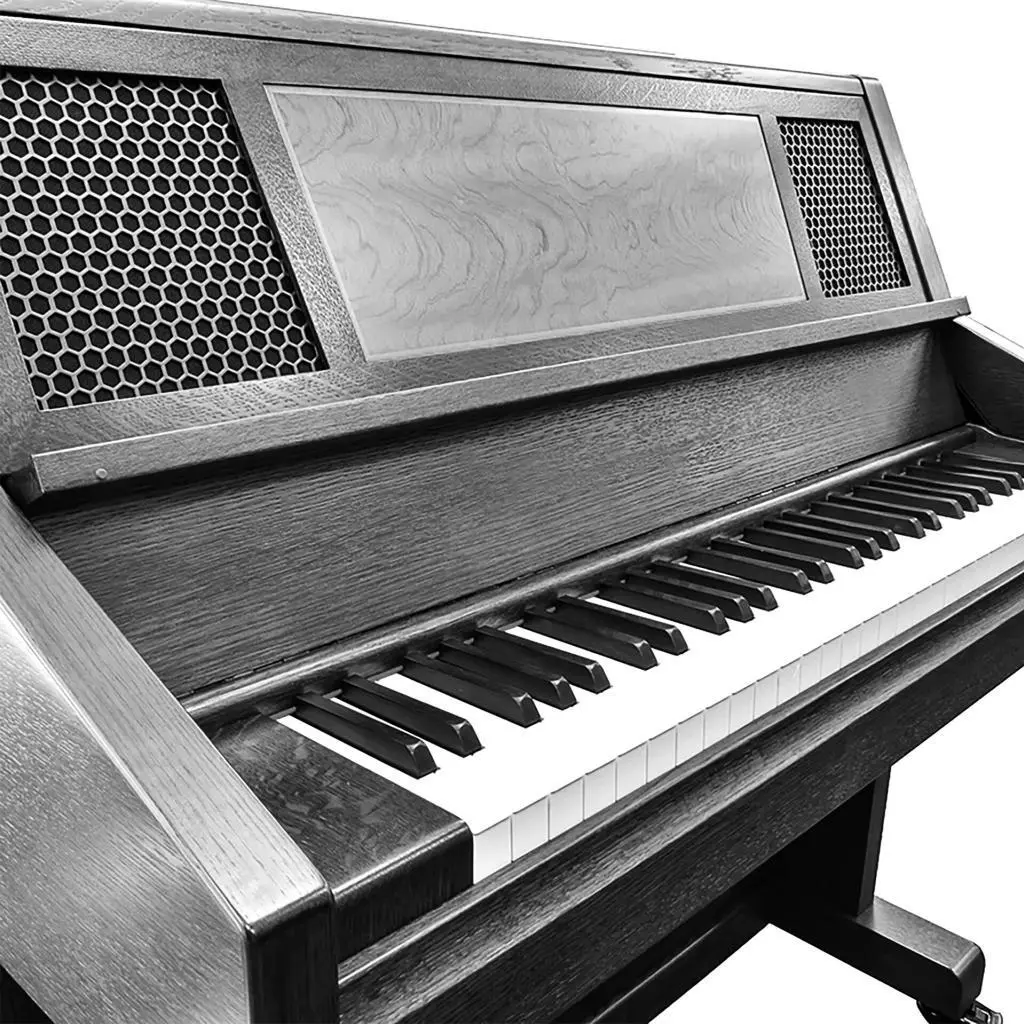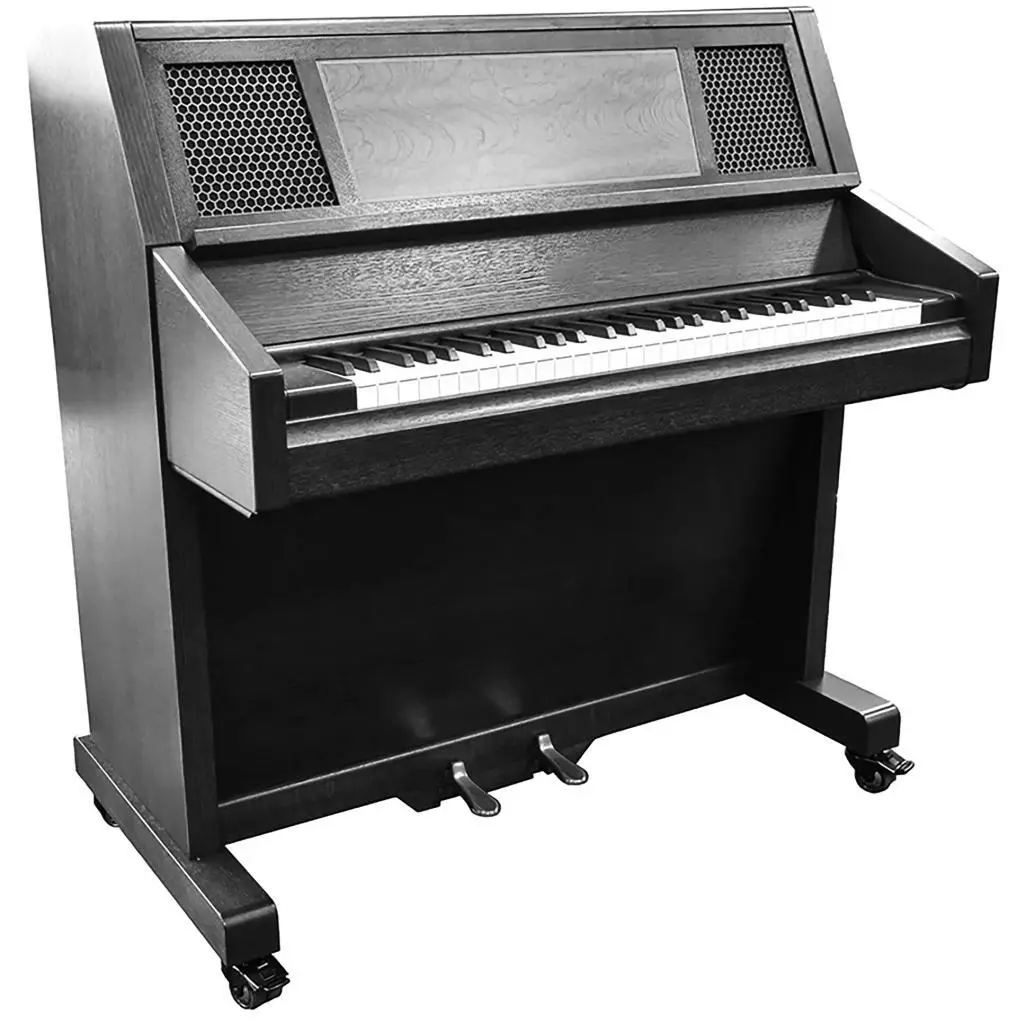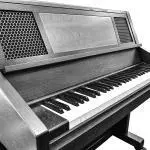The celesta is a keyboard-operated idiophone, similar to an upright piano but smaller, where hammers strike metal plates over wooden resonators, producing a bell-like, delicate sound.

What is Celesta: Table of Contents
The celesta, often referred to as a “keyboard glockenspiel,” is a captivating and unique musical instrument with a rich history and distinct tonal quality. Invented in 1886 by Auguste and Louis Mustel, the celesta quickly gained popularity in the late 19th and early 20th centuries, and has since been used in a wide range of musical genres, from classical and romantic music to popular music, jazz, and electronic music. Its ethereal and delicate sound is created by steel bars resting on felt supports over wooden resonators, which are struck by felt hammers when the keys on the keyboard are pressed. In this blog, we will delve into the fascinating world of the celesta, exploring its history, construction, playing technique, tone, versatility, and notable performances.
History of the Celesta
The celesta has a fascinating history that traces back to its invention in Paris in 1886 by Auguste and Louis Mustel, who were prominent French harmonium manufacturers. Originally known as the “céleste,” the instrument was aptly named for its celestial and otherworldly sound that captivated musicians and audiences alike.
The Mustel brothers designed the celesta as a keyboard percussion instrument that used steel bars and wooden resonators to produce its unique tones. The bars were struck by felt hammers, which created a bell-like sound with a delicate and ethereal quality. The celesta’s innovative design and mesmerizing tone quickly gained popularity and it found its way into the works of prominent composers of the time.
One of the most famous and influential composers to embrace the celesta was Pyotr Ilyich Tchaikovsky. He featured the instrument prominently in his iconic ballet “The Nutcracker,” where the celesta’s distinct sound was used to represent the magical character of the Sugar Plum Fairy. Tchaikovsky’s use of the celesta in “The Nutcracker” helped to cement its place in the classical music repertoire and introduced it to audiences around the world.
In addition to Tchaikovsky, other notable composers such as Claude Debussy, Maurice Ravel, and Igor Stravinsky also embraced the unique timbre of the celesta in their compositions. Debussy used the celesta in his orchestral work “Prelude to the Afternoon of a Faun,” creating a dreamlike and mystical atmosphere. Ravel incorporated the celesta in his piano piece “Gaspard de la nuit,” where its sparkling tones added a touch of magic to the music. Stravinsky also used the celesta in his ballet “The Firebird,” further showcasing its versatility and charm.
In the early 20th century, the celesta became a staple in orchestras and chamber ensembles, finding its way into many classical compositions. Its use expanded beyond classical music and it started to appear in other genres such as jazz and popular music. The celesta’s unique sound and versatility made it a sought-after instrument for composers seeking to create enchanting, otherworldly, or dreamlike atmospheres in their music.
Over the years, the celesta has continued to evolve in its design and construction. Modern celestas often feature improvements in materials and construction techniques, but the basic principles of its invention remain largely unchanged. The instrument typically consists of a wooden case with steel bars that are struck by felt hammers, creating its signature bell-like sound.
Today, the celesta remains a beloved and distinctive instrument in the world of music. Its delicate, sparkling tones and otherworldly timbre continue to captivate audiences and inspire composers to create magical and enchanting compositions. Whether in classical, jazz, or contemporary music, the celesta continues to be a cherished addition to many musical works, carrying on the legacy of its inventive origins by the Mustel brothers over a century ago.
Celesta Construction and Design

The celesta’s construction consists of steel bars, felt supports, and wooden resonators. The steel bars are carefully tuned to specific pitches and are mounted horizontally above the wooden resonators, which serve as amplifiers for the sound. The resonators are usually made of hardwood, such as maple or beech, and are carefully crafted to enhance the tonal quality of the instrument. The bars are struck from above by felt hammers when the keys on the keyboard are pressed, producing the distinct sound of the celesta.
The keyboard layout of the celesta is similar to that of a piano, with white and black keys arranged in a chromatic scale. However, unlike a piano, the celesta does not have strings and does not rely on strings and a soundboard for amplification. Instead, the steel bars directly produce the sound when struck by the felt hammers, and the wooden resonators help to amplify and shape the tone.
Playing Technique and Performance
Playing the celesta requires a delicate touch and precise technique. The player uses the keyboard to activate the felt hammers, which strike the steel bars to produce the sound. The intensity of the sound can be controlled by adjusting the force with which the keys are pressed. Dynamics, expression, and articulation can also be controlled through the use of touch and pedal techniques.
The playing technique of the celesta shares similarities with other keyboard and percussion instruments, but it also has its unique characteristics. Due to the small size and delicate nature of the instrument, accurate finger placement and control are crucial to produce the desired tone. The player needs to be mindful of the instrument’s limited sustain and decay, as well as the specific timbral characteristics of the celesta’s sound.
Notable performers of the celesta include prominent percussionists and keyboardists in orchestras and chamber ensembles. The instrument has been featured in numerous classical and contemporary compositions, as well as in popular music genres. Notable performances that feature the celesta include Tchaikovsky’s “Dance of the Sugar Plum Fairy” from “The Nutcracker,” Debussy’s “Clair de Lune,” and John Williams’ iconic score for the movie “Harry Potter and the Philosopher’s Stone,” among many others. The celesta’s unique and enchanting sound has made it a favorite choice for composers and performers alike, adding a touch of magic and wonder to countless musical works.
Tonal Quality and Versatility of the Celesta
The celesta’s sound is often described as ethereal, bell-like, and delicate. The steel bars produce a shimmering, crystalline tone that is reminiscent of a glockenspiel, but with a softer and warmer quality due to the use of felt hammers and wooden resonators. The instrument’s timbre is distinctive and instantly recognizable, making it a valuable addition to any musical composition or performance.
The celesta’s versatility is one of its greatest strengths. Its unique sound allows it to blend seamlessly with other instruments in an ensemble or orchestra, and it can be used in a wide range of musical genres and styles. In classical music, the celesta is often used to create a sense of magic, mystery, or otherworldliness, as well as to depict twinkling stars, shimmering ice, or other atmospheric effects. In popular music, the celesta has been used in a variety of ways, from adding a touch of nostalgia or innocence to ballads, to creating a sense of wonder and enchantment in film scores.
The celesta has also found its way into jazz, electronic music, and experimental genres, where its unique sound and expressive capabilities have been creatively explored. Its ability to produce sustained tones, staccato notes, and glissandi, combined with its delicate and enchanting timbre, make it a versatile and expressive instrument that can add depth, character, and emotion to any musical composition.
Notable Celesta Manufacturers and Models
Mustel, the original inventors of the celesta, were one of the earliest and most prominent manufacturers of the instrument. The Mustel celestas were highly regarded for their craftsmanship and tonal quality, and they set the standard for future generations of celesta manufacturers. Mustel celestas were known for their distinctive design, which featured a wooden case and resonators made of metal or brass tubes. Their instruments were known for their warm, rich tones and delicate bell-like sound.
Yamaha, a renowned musical instrument manufacturer, also produces celestas of high quality. Yamaha celestas are known for their modern designs, superior craftsmanship, and consistent tonal quality. Yamaha offers a range of models, from professional-grade instruments used in orchestras and studios to more affordable options for students and amateur musicians. Their celestas often feature a sleek and compact design, making them easy to transport and set up for performances or recordings.
Schiedmayer, a German piano and celesta manufacturer, is another notable name in the world of celestas. Schiedmayer celestas are highly regarded for their craftsmanship and tonal excellence. They are known for their attention to detail in the construction of the steel bars and resonators, which results in a unique and beautiful sound. Schiedmayer celestas are often used by professional musicians and can be found in orchestras and recording studios around the world.
Bergerault, a French percussion instrument manufacturer, is also known for producing high-quality celestas. Bergerault celestas are often favored by professional musicians for their tonal quality and versatility. They offer a range of models with different keyboard ranges and features, including pedal systems for controlling sustain or damping. Bergerault celestas are known for their durability and playability, making them a popular choice among professional musicians and educators.
In addition to Mustel, Yamaha, Schiedmayer, and Bergerault, there are other manufacturers who produce celestas of varying designs and quality, catering to the diverse needs and preferences of musicians. Some manufacturers offer custom-made celestas, allowing musicians to choose specific features and materials to suit their individual requirements.
There are also different models of celestas available in the market, each with its own unique features and specifications. Some models have a smaller keyboard range, typically spanning four to five octaves, while others have a larger range, allowing for greater versatility in performance. The size and weight of the instrument can also vary, with some models being more compact and portable than others.
Some celesta models feature a pedal system for controlling sustain or damping, similar to a piano pedal, allowing for more expressive playing. Others rely solely on the touch of the player to control the sound. The design of the resonators, which are responsible for amplifying the sound of the steel bars, can also vary among different models and manufacturers. The materials used in the construction of the instrument, such as the type of wood for the case and the quality of the steel bars, can also affect the instrument’s tonal quality and playability.
Maintenance and Care for Celestas
Like any musical instrument, the celesta requires proper maintenance and care to ensure its longevity and optimal performance. Regular tuning is essential to keep the steel bars in proper pitch, and adjustments may be needed to maintain consistent touch and response across the keyboard. The felt hammers may also need periodic replacement or reshaping to ensure optimal sound production.
Proper maintenance and care are essential for keeping a celesta in optimal condition and ensuring its longevity and performance.
Tips and Tricks for Maintaining and Caring Your Celesta
- Regular tuning: Just like pianos, celestas require regular tuning to keep the steel bars in proper pitch. Hire a professional tuner who has experience with celestas to ensure accurate tuning and maintain consistent tonal quality.
- Keyboard adjustments: Celestas may require adjustments to maintain consistent touch and response across the keyboard. If you notice any keys that are sticking, uneven, or not producing the desired sound, it may be necessary to have them adjusted by a qualified technician.
- Hammer maintenance: The felt hammers of the celesta may need periodic maintenance, such as reshaping or replacement, to ensure optimal sound production. Over time, the felt hammers can wear down or become compressed, affecting the instrument’s tone and playability.
- Resonator care: The wooden resonators of the celesta should be kept clean and free from dust and debris. Regularly dust the resonators using a soft, dry cloth or a brush to prevent dirt or dust from accumulating, which can affect the instrument’s tonal quality. If the resonators become dirty or damaged, consult a qualified technician for refinishing or repair.
- Climate-controlled storage: Proper storage is important for protecting the celesta from changes in temperature and humidity, which can affect the instrument’s stability and tonal quality. Ideally, store the celesta in a climate-controlled environment with stable temperature and humidity levels to prevent warping, cracking, or other damage.
- Clean hands: When playing the celesta, always use clean hands to prevent oils and dirt from transferring onto the steel bars or keys. Oils and dirt can affect the instrument’s sound and playability, so it’s important to keep the keys and steel bars clean.
- Cover when not in use: When the celesta is not in use, it’s advisable to cover it with a protective cover to prevent dust and accidental damage. Use a cover specifically designed for musical instruments or a soft, breathable fabric cover that allows air circulation.
DIY Maintenance Tips
- Avoid using harsh cleaning chemicals or abrasive materials on the celesta, as they can damage the finish or the steel bars. Stick to using a soft, dry cloth or a brush for dusting and cleaning.
- If you notice any keys that are sticking, you can try gently tapping the affected keys or using a small amount of compressed air to clean any debris that may be causing the issue. However, if the problem persists, it’s best to consult a qualified technician for professional adjustments.
- Keep an eye on the condition of the felt hammers. If they appear worn down or compressed, you may be able to reshape them using a soft, fine-grit sandpaper or by carefully trimming the felt. However, if the hammers are significantly damaged, it’s best to have them replaced by a qualified technician.
- If you’re storing the celesta for an extended period, make sure it’s in a dry, well-ventilated area to prevent moisture buildup, which can lead to mold or mildew growth. Consider using a dehumidifier or a moisture-absorbing packet to keep the environment dry.
- Avoid placing heavy objects on the celesta, as it can cause damage to the wooden case or the steel bars. Also, avoid resting elbows or leaning on the instrument while playing, as it can put unnecessary pressure on the keys and affect the touch and response of the instrument.

